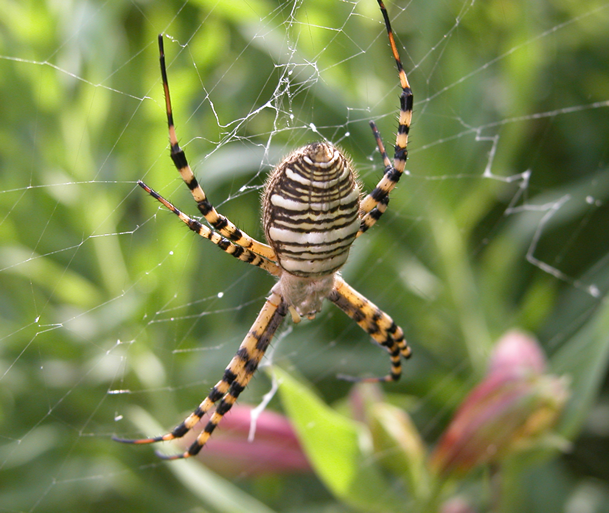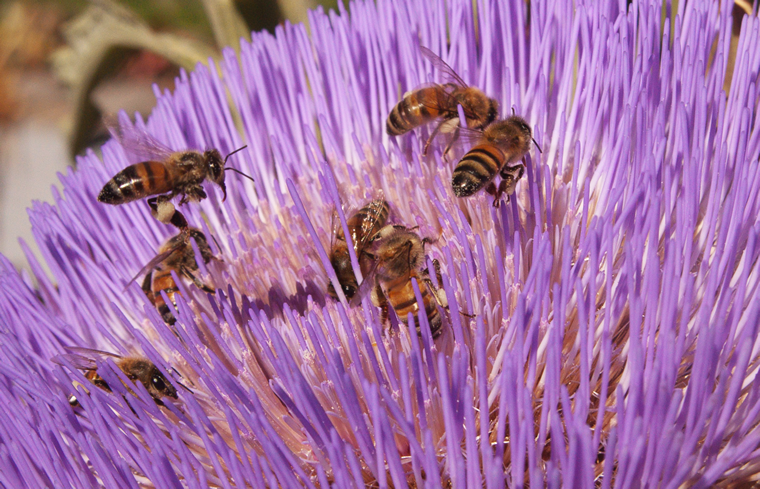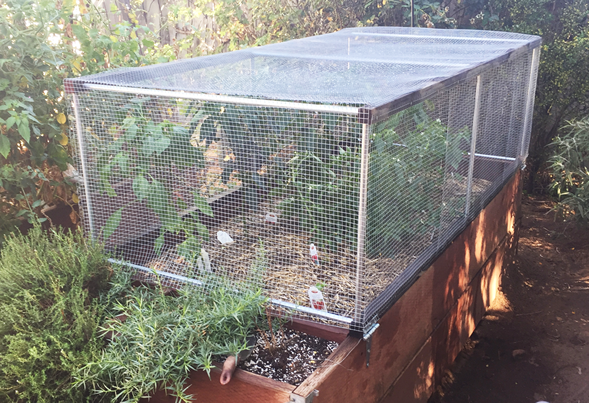A smart way to sort out garden friend from foe

A yellow garden spider (Argiope aurantia) is a beneficial guest in the yard.(Joe Boldt)
BY JOE BOLDT
(This article first appeared in the San Diego Union-Tribune on February 12, 2022)
Whisper the phrase “Integrated Pest Management,” or worse, “IPM” at your local garden club meeting and even the most erudite gardener might be seen fleeing to the nearest exit.
Just what is Integrated Pest Management and why should you care? In short, it’s a method of controlling garden pests while doing the least harm to the environment. With a focus on preventing problems, IPM takes a long-term approach to managing pests by using a combination of methods. Let’s take a look at some of these methods.
Monitoring
As you wander about your garden in your bathrobe and clogs, morning coffee in hand, pay attention! When you spot an insect on a leaf, take a closer look, and then ask yourself: Is there just the one? Are they everywhere in my garden or just this plant? Is there any damage to the plant? Which brings us to:
Name that pest
The single most important IPM step is identification. Knowing what pest you have will provide insight into how much damage it might do. You may even discover it’s beneficial. Not all insects are pests, and most are benign. If it is a pest, knowing what it is will help you find solutions that do the least damage to the environment.

Bees helpfully pollinate an artichoke blossom.(Joe Boldt)
Threshold
You’ve identified your pest. Now what? What is your threshold on how much damage you’re willing to live with before you need to do something? Perhaps you don’t need to do anything. Losing a few leaves on a vine to a caterpillar probably doesn’t warrant any action. In small numbers, only a little damage may occur.
Watching a prize rosebush being dragged underground by a pocket gopher, however, might suggest a “Caddyshack”-like response!
It’s important to realize we don’t live in a sterilized environment. There will always be some plant damage; we just need to learn to live with a little.
Biological controls
Remember the earlier mention of beneficial insects? They are a type of biological pest control. To help control aphids, buy a container of lady beetles from your local nursery and release them in your garden (in the evening to help ensure they don’t fly away). That giant spider that seems to always build a web across your path at head height also eats lots of insects.
A caterpillar infestation can be treated with Bacillus thuringiensis, or Bt, a naturally occurring microbe that generates toxins deadly to insect larvae. Be sure to read the label to find what the target pest is. Are you trying to raise monarch butterflies? Make sure you don’t spray Bt on milkweed!
Cultural controls
For hundreds of years, gardeners have known not to plant the same crop in the same place year after year. This “crop rotation” is a form of cultural control that helps reduce pest establishment by changing where a host plant grows. For example, growing your favorite variety of tomato in the same place may bring on root-knot nematodes. Plant it in a different location next year and the nematodes will reduce over time in the absence of a host.
Does your zucchini get powdery mildew? Try planting a disease-resistant variety. Try not to get water on the leaves and irrigate in the morning so the plant can dry off during the day. Another example of cultural control is site selection. If you place the plant in its ideal location it will be better able to fend off pests because it will grow healthier.

Physical barriers on plants can keep out unwanted visitors. (Joe Boldt)
Mechanical and physical controls
Should you find aphids on your citrus, you will likely also see ants busily scurrying up and down the tree. Ants “farm” aphids for the “honeydew” they secrete. They even move them about the plant to start fresh colonies. Keeping the ants off the tree with a sticky substance such as Tanglefoot, a super-sticky compound that protects against certain insects, is one method of mechanical control. Another is to use a sharp spray of water from your hose to smash and dislodge the aphids directly. Yet another is gleefully squishing them between your fingers!
Sometimes the best way to keep pests out is to physically exclude them. If the local rat population is harvesting more of your peppers than you are, it may be time to build a barrier over your raised beds. Growing cabbages under row cloth will keep out cabbage loopers.
The simplest physical control is your fingers! So, pick up all those snails and throw them in a bin.
Chemical controls
Finally, we come to chemicals. In IPM, pesticides are the last recourse and are only used in conjunction with other methods for long-term control. Sometimes pesticides are the final and best hope when other methods have failed. Apply the product in a way that will do the least harm to nontargeted organisms and the environment. Use a selective product that is aimed at the pest you are trying to control.
In the end, Integrated Pest Management isn’t this crazy complicated system designed to keep you awake at night. Rather, it’s a commonsense, long-term approach to keep your pest issues low and your gardening enjoyment high.
You can learn much more about IPM at the UC Agriculture and Natural Resources website.
Boldt has been a UCCE Master Gardener since 2005. He enjoys growing unique plants and peculiar vegetables, and cooking.

